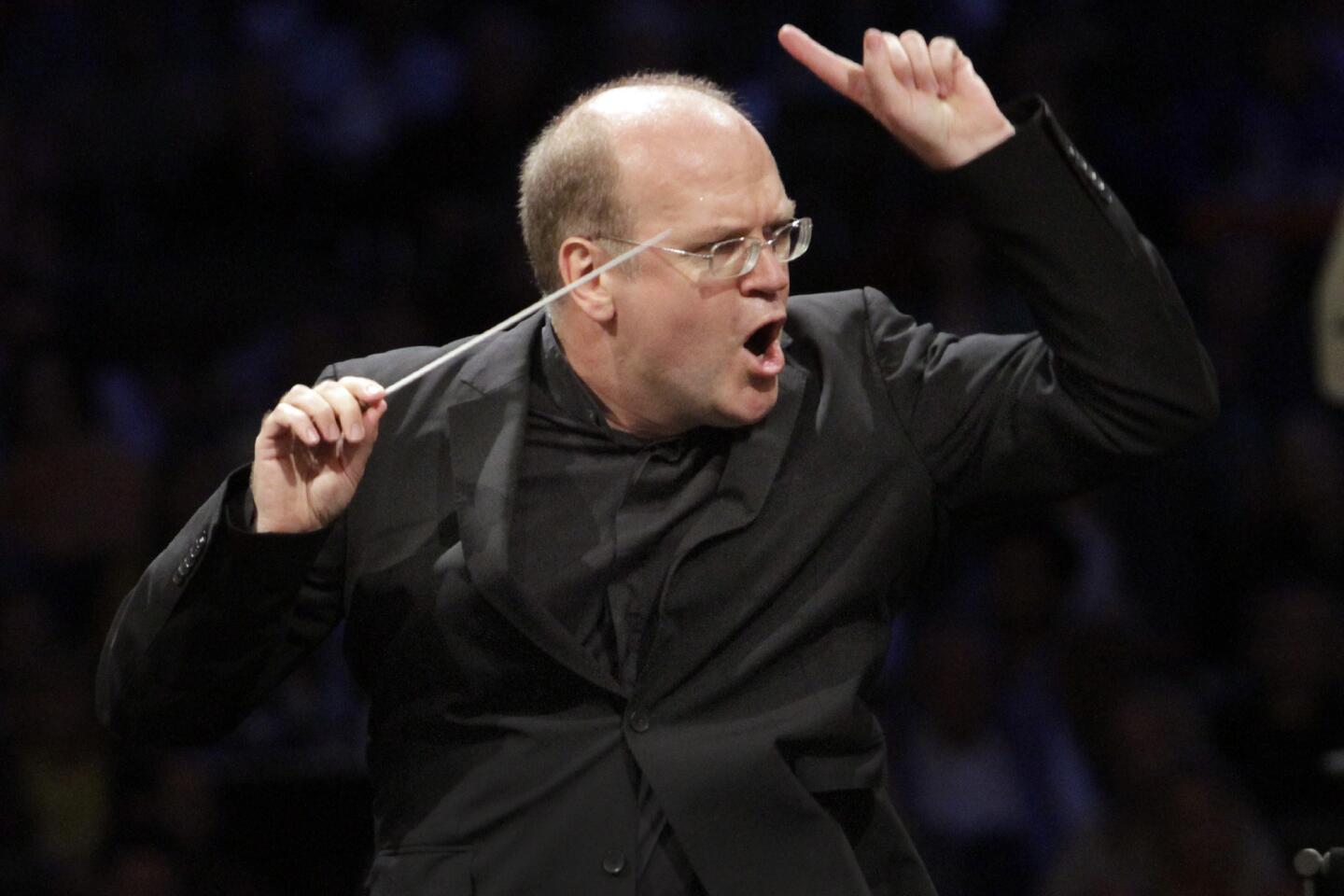Review: A sonically enhanced ‘Night of Elegance’ at the Bowl
Forget video for now, those incandescent new hi-def Hollywood Bowl screens that are delighting some Los Angeles Philharmonic fans and driving others away. Let’s talk sound. The new amplification equipment has been enthusiastically embraced by, it seems, everyone.
On Tuesday night, that sound system made all the difference in the world. The program, advertised as “A Night of Elegance,” was music by Mozart, Mendelssohn and Schubert. The L.A. Phil was kept small to conform to the size of ensembles typically available to those composers. The conductor was Bernard Labadie, who specializes in the baroque and classical eras, and who heads early music groups in Québec patterned after the French courts of yore. He does elegance with a certain regularity.
The soloists were pianists Katia and Marielle Labèque. When they want to, these popular sisters can do elegance too, in their snazzy way. Plus, their French sense of style is unmistakable. A further assist from the French came from the audio firm, L-Acoustics, that manufactured the new loudspeakers that produce an unusually elegant outdoor sound.
PHOTOS: Arts and culture in pictures by The Times
As with the Labèques, the new speakers are most notable for their dynamism. The same goes for Mendelssohn, no matter that many millions of nuptials have been accompanied by the Wedding March from the composer’s incidental music to “A Midsummer Night’s Dream.” It has to be one of the most popular pieces ever written. But our relationship with Mendelssohn is a peculiar one, and that is what the Bowl addressed in this program and why we needed amplification that could make an impression.
Mendelssohn wrote eight concertos, along with other, smaller pieces for soloists and orchestra. I don’t know that statistics are kept, but I would be surprised to learn that any violin concerto is played more often than Mendelssohn’s D-Minor one. Two brilliant piano concertos are very occasionally dusted off. The rest are neglected, although they have a handful of champions in high places, such as violinist Gidon Kremer and pianist Martha Argerich.
The reason these concertos aren’t in the repertory is mainly because they’re thought of as juvenilia. Mendelssohn wrote the first of his two concertos for two pianos and orchestra — the one on Tuesday’s program — when he was 15 for the composer and his sister, Fanny, to play. He was inspired by and took as his starting point Beethoven’s “Emperor” Concerto. It is highly precocious, which is all well and good.
CHEAT SHEET: Spring Arts Preview
But Mendelssohn at 15 was like no other prodigy at 15. At only 17, he wrote the Overture to “A Midsummer Night’s Dream,” which has been called by many a musicologist the most original, accomplished and impressive work by any composer of that age, Mozart and Schubert included.
Mendelssohn’s Concerto for Two Pianos in E-flat is simply a marvel. It may slightly imitate Beethoven but it goes off in its own direction much of the time. The tunes stick. The vibrancy, though, is its biggest attraction. Here is a 15-year-old with the chops to express what it feels like to be a 15-year-old on top of the world, at least musically.
The piano writing is full of exuberant flourishes, but also tender and sweet, and the Labèques played with sprightly joy. Still, they needed a sound system that could give the piano a sonic sense of both metal and flesh, and deposit that sound directly to your ears to make you believe that. And believers we became.
TIMELINE: Summer’s must see concerts
Whatever elegance was to be found in the Mendelssohn was then left behind in the Labèques’ electrifying encore — Witold Lutoslawski’s “Variations on a Theme by Paganini.” This was of interest because this year is the 100th anniversary of the Polish composer’s birth, and also because the variations are on the same 24th Caprice for solo violin that Augustin Hadelich played as an encore at the Bowl a week earlier.
What the Labèques proved with the Lutoslawski is that exciting 20th century music, which the L.A. Phil shies away from at the Bowl, can turn an audience on. The sisters burned the keys, and the audience loved them for it.
Labadie began with “The Marriage of Figaro” Overture. After the recent run of the Mozart opera under Gustavo Dudamel, the L.A. Phil could probably have played this in its collective sleep. Labadie’s account was gracious, but he didn’t attempt the overtly sprightly manner that he might have if working with his own period-instrument players.
Schubert’s Fifth, the most conventional of his mature symphonies, made for a somewhat undernourished second half of the program. Labadie was here conventional as well, not too slow and not, in the early music manner, really fast. The shaping of phrases was, indeed, elegant. But with more rehearsal, the performance might have had a bit more snap. The new sound system is a great boon to the Bowl, but it’s only stereo equipment — it can’t do everything.
More to Read
The biggest entertainment stories
Get our big stories about Hollywood, film, television, music, arts, culture and more right in your inbox as soon as they publish.
You may occasionally receive promotional content from the Los Angeles Times.
















